学术论文英文翻译 [科技学术论文英文翻译参考]
科技英语翻译文稿[五篇范例]
![科技英语翻译文稿[五篇范例]](https://img.taocdn.com/s3/m/32d96b2c78563c1ec5da50e2524de518964bd3d8.png)
科技英语翻译文稿[五篇范例]第一篇:科技英语翻译文稿Wireless Network Accurately and Inexpensively MonitorsPatients' Breathing无线网络事实上是廉价地监控着病人的呼吸状况。
A couple years ago we saw wireless technology that would allow us to see through walls.Now,几年以前我们就可以看到无线网络可以让我们看到“墙外的东西”。
现在,来自犹他州州立thesame team of researchers, from the University of Utah, is putting that motion detection大学的同一个技术团队正在把移动式检测技术technology to work monitoring breathing patterns.So not only can the network see through your 运用到检测病人的呼吸状况上因此通过网络不仅可以远程观察病人的现状,它甚至可以听到bedroom wall, it can hear you breathing.Less sinisterly, the system could help doctors keep你的呼吸。
这个系统可以帮助医生更好的监控患者睡眠时的呼吸暂停事件,急救病人或婴儿 better track of patients with sleepapnea, surgery patients or babies at risk for sudden infant 的发生突然猝死危险性就变得更低了。
death syndrome.Team leader Neal Patwari demonstrated the system by lying in a hospital bed surrounded by这个团队的带头人尼尔帕特维尔躺在一家医院的病床上,周围布置了20个工作频率为2.4G 20 wireless transceivers operating at a frequency of 2.4 gigahertz.He timed his breathing to be赫兹的无线电收发器以演示这个监控系统的工作状况。
科技英文作文模板带翻译
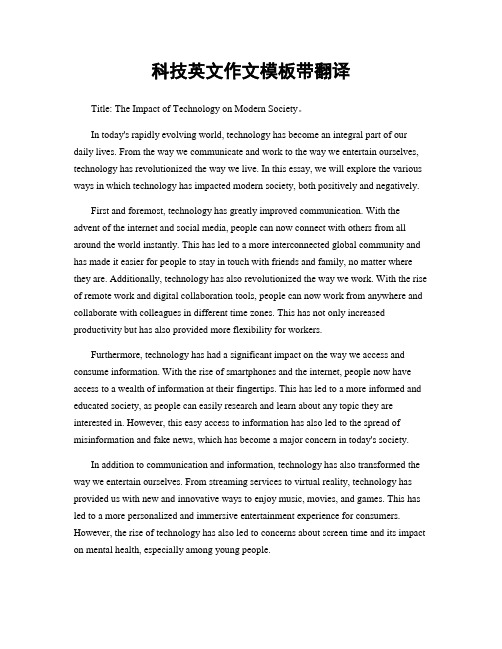
科技英文作文模板带翻译Title: The Impact of Technology on Modern Society。
In today's rapidly evolving world, technology has become an integral part of our daily lives. From the way we communicate and work to the way we entertain ourselves, technology has revolutionized the way we live. In this essay, we will explore the various ways in which technology has impacted modern society, both positively and negatively.First and foremost, technology has greatly improved communication. With the advent of the internet and social media, people can now connect with others from all around the world instantly. This has led to a more interconnected global community and has made it easier for people to stay in touch with friends and family, no matter where they are. Additionally, technology has also revolutionized the way we work. With the rise of remote work and digital collaboration tools, people can now work from anywhere and collaborate with colleagues in different time zones. This has not only increased productivity but has also provided more flexibility for workers.Furthermore, technology has had a significant impact on the way we access and consume information. With the rise of smartphones and the internet, people now have access to a wealth of information at their fingertips. This has led to a more informed and educated society, as people can easily research and learn about any topic they are interested in. However, this easy access to information has also led to the spread of misinformation and fake news, which has become a major concern in today's society.In addition to communication and information, technology has also transformed the way we entertain ourselves. From streaming services to virtual reality, technology has provided us with new and innovative ways to enjoy music, movies, and games. This has led to a more personalized and immersive entertainment experience for consumers. However, the rise of technology has also led to concerns about screen time and its impact on mental health, especially among young people.Moreover, technology has had a profound impact on various industries, such as healthcare, transportation, and finance. In healthcare, technology has led to significant advancements in medical treatments, diagnostic tools, and patient care. In transportation, technology has led to the development of electric and autonomous vehicles, which have the potential to revolutionize the way we travel. In finance, technology has led to the rise of digital banking and cryptocurrencies, which have changed the way we manage and exchange money.Despite the numerous benefits of technology, there are also several drawbacks that come with its widespread use. One of the major concerns is the impact of technology on job displacement. With the rise of automation and artificial intelligence, many jobs are at risk of being replaced by machines. This has led to concerns about unemployment and income inequality. Additionally, the overreliance on technology has also raised concerns about privacy and security. With the amount of personal data being collected and stored online, there is a growing concern about data breaches and cyber-attacks.In conclusion, technology has undoubtedly transformed modern society in numerous ways. From communication and information to entertainment and industry, technology has revolutionized the way we live and work. However, it is important to be mindful of the potential drawbacks of technology and to address the challenges it presents. By doing so, we can ensure that technology continues to benefit society while minimizing its negative impact.。
英文文献 科技类 原文及译文33
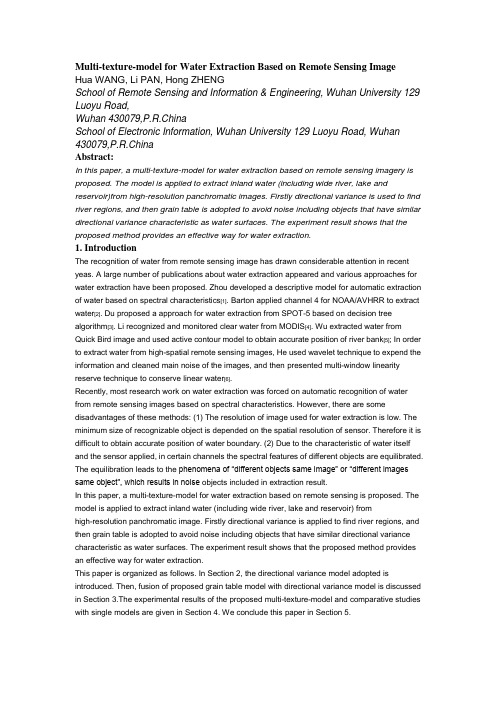
Multi-texture-model for Water Extraction Based on Remote Sensing ImageHua WANG, Li PAN, Hong ZHENGSchool of Remote Sensing and Information & Engineering, Wuhan University 129 Luoyu Road,Wuhan 430079,P.R.ChinaSchool of Electronic Information, Wuhan University 129 Luoyu Road, Wuhan 430079,P.R.ChinaAbstract:In this paper, a multi-texture-model for water extraction based on remote sensing imagery is proposed. The model is applied to extract inland water (including wide river, lake and reservoir)from high-resolution panchromatic images. Firstly directional variance is used to find river regions, and then grain table is adopted to avoid noise including objects that have similar directional variance characteristic as water surfaces. The experiment result shows that the proposed method provides an effective way for water extraction.1. IntroductionThe recognition of water from remote sensing image has drawn considerable attention in recent yeas. A large number of publications about water extraction appeared and various approaches for water extraction have been proposed. Zhou developed a descriptive model for automatic extraction of water based on spectral characteristics[1]. Barton applied channel 4 for NOAA/AVHRR to extract water[2]. Du proposed a approach for water extraction from SPOT-5 based on decision tree algorithm[3]. Li recognized and monitored clear water from MODIS[4]. Wu extracted water from Quick Bird image and used active contour model to obtain accurate position of river bank[5]; In order to extract water from high-spatial remote sensing images, He used wavelet technique to expend the information and cleaned main noise of the images, and then presented multi-window linearity reserve technique to conserve linear water[6].Recently, most research work on water extraction was forced on automatic recognition of water from remote sensing images based on spectral characteristics. However, there are some disadvantages of these methods: (1) The resolution of image used for water extraction is low. The minimum size of recognizable object is depended on the spatial resolution of sensor. Therefore it is difficult to obtain accurate position of water boundary. (2) Due to the characteristic of water itself and the sensor applied, in certain channels the spectral features of different objects are equilibrated. The equilibration leads to the phenomena of “different objects same image” or“different images same object”, which results in noise objects included in extraction result.In this paper, a multi-texture-model for water extraction based on remote sensing is proposed. The model is applied to extract inland water (including wide river, lake and reservoir) fromhigh-resolution panchromatic image. Firstly directional variance is applied to find river regions, and then grain table is adopted to avoid noise including objects that have similar directional variance characteristic as water surfaces. The experiment result shows that the proposed method provides an effective way for water extraction.This paper is organized as follows. In Section 2, the directional variance model adopted is introduced. Then, fusion of proposed grain table model with directional variance model is discussed in Section 3.The experimental results of the proposed multi-texture-model and comparative studies with single models are given in Section 4. We conclude this paper in Section 5.2. Directional Variance ModelThe aim of our research is to extract water larger than 100m2from panchromatic images. As shown in Figure 2(a), the research objects can be divided into three classes: wide river, lake and reservoir, which all represent as region in high-resolution imageries. The objects of background can be divided into two classes: building and cropland, which also represent as region.In panchromatic imagery, wide river has a similar gray level to building and cropland, though the mean grayof lake and reservoir is much lower than the background objects. Conventional methods for water extraction based on spectral characteristics are not effective in the situation. In the meantime, water body defines homogeneous areas whereas building and cropland correspond to heterogeneous regions. Therefore, we take into account the homogeneity of the image to separate wide river, lake and reservoir from background instead. To characterize the difference of homogeneity between water body and the other types of areas, we use a textual operator: the directional variance.2.1. The Directional Variance OperatorThe operator is derived from those defined by Guerin & Maitre and Airault & Jamet[10]. As shown in Figure1, the directional variance consists in computing, for each pixel M of the image, the variance of the gray levels of the image on several direction of a circle whose center is M and radius is R. Then, the direction with the highest variance value is kept. Its direction defines the direction for which image is the most heterogeneous, locally. Its variance value is the directional variance value of the pixel M.2.2. Extraction of water based on directional varianceAccording to the definition of the operator, the minimum acreage of recognizable water body is depended on the length of radius R. We have chosen a length of 10 pixels for 1m resolution. The directional variances of the five typical training samples (wide river, lake, reservoir, building and cropland) have been computed and the statistical comparison is summarized in Table1. The overall average of water directional variance is lower than the objects of background.Nevertheless, the directional variance of cropland is similar to wide river with overlapping potion over 90%.Inhigh-resolution panchromatic imagery, details inside wide river, such as boat, wave, etc, are represented clearly which result in the heterogeneous of water. In the meantime, the textures of parts of building (for example, roof ) and cropland are rather fine. In a small window, these potions define homogeneous areas with similar directional variance as wide river. The result is improved if we chosen a length of 100 pixels. The statistical comparison is shown in Table2. If the length of radius is large enough, directional variance of building is higher than other objects obviously with no overlapping portion; the difference between cropland and wide river is increased while the overlapping potion is decreased. However, increasing the radius leads to two problems which are outlined as follow:1) The size of recognizable water body increases;therefore water which has small acreage (for example narrow river) can not be detected.2) The position of water bank is not accurate although the spatial resolution of imagery is rather high.Hence, in this paper, a multi-texture-model is presented and two texture models are fused to extract water from panchromatic images. Firstly, we chose a radius of 10 pixels to extract water based on directional variance; and then, grain table is adopted to avoid noise including parts of building and cropland that have similar directional variance characteristic as water surface.3. Multi-texture-modelIn high-resolution imagery, cropland and building represents structural characteristic. According to this characteristic, grain analysis is adopted for further research on the original extraction based on directional variance. The grain table histogram is able to represent structural characteristic of the research object, which can be applied to recognize many kinds of different objects [12].3.1. Extraction of water fused by grain tableThe grain table histograms of the five typical training samples (wide river, lake, reservoir, building and cropland) are computed and correlation coefficients between them are summarized in Table3. Correlation coefficients between water classes are over 85%, however, correlation coefficients between water classes and background classes are lower than 65%.Hence, we compare the correlation coefficients of regions in extraction image base on directional variance with three water samples and two background samples respectively. If the region has a higher correlation coefficient with background classes, it will be marked background and wiped off[13].4.Experimental ResultsWe run the algorithm on several high-resolution panchromatic images. In Figure2.(a), we have been considering an aerial photograph(6126×4800) of a region in Wuhan, China, the resolution of which is 1m,including building, cropland, wide river( Changjiang river), lake, reservoir and cropland. The results of extraction based on directional variance with radius of 10 pixels is displayed in Figure2.(b), and clearly, water has been detected completely, whereas parts of building and cropland are included as noise objects in the result. Water extraction using directional variance with radius of 100 pixels is displayed in Figure2.(c)with correctness over 95%, however, small lakes are missed and the position of bank is not as accurate as Figure2.(b). Finally, in Figure2.(d), the result of Figure2.(b) is fused by grain table analysis, so that the correctness and completeness of extraction are both over 90%.5. ConclusionsBased on textural analysis of water in high-resolution panchromatic imagery, a multi-texture-model is presented for water extraction.The experimental results proved that the approach is efficient for inland water (including wide river, lake and reservoir) extraction. As the complexity and diversity of water, the rate of recognition of our algorithm fluctuates. Furthermore, the method is supervised which needs a lot of human interference to obtain training samples. Therefore, there are problems to be solved in future:1) Our further work should be extensible to multispectral remote sensing images.2) To decrease human interference, old vector will be applied to obtain training samples instead. 6. AcknowledgmentsThe work was supported by the National Key Technology R&D Program of China under grant No.2006BAB10B01.根据遥感图象的多纹理模型相关的水抽取Hua WANG, Li PAN, Hong ZHENGSchool of Remote Sensing and Information & Engineering, Wuhan University 129 Luoyu Road,Wuhan 430079,P.R.ChinaSchool of Electronic Information, Wuhan University 129 Luoyu Road, Wuhan 430079,P.R.China文摘:在本文中,提议了一个多纹理模型为根据遥感成像的水提取。
科技文献中英文对照翻译
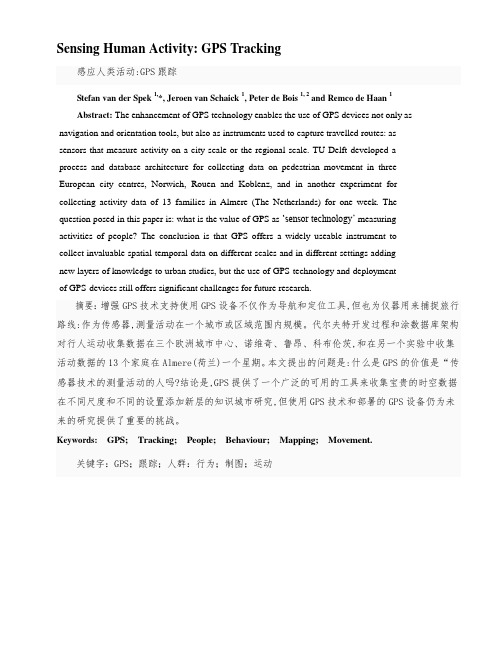
Sensing Human Activity:GPS Tracking感应人类活动:GPS跟踪Stefan van der Spek1,*,Jeroen van Schaick1,Peter de Bois1,2and Remco de Haan1Abstract:The enhancement of GPS technology enables the use of GPS devices not only as navigation and orientation tools,but also as instruments used to capture travelled routes:assensors that measure activity on a city scale or the regional scale.TU Delft developed aprocess and database architecture for collecting data on pedestrian movement in threeEuropean city centres,Norwich,Rouen and Koblenz,and in another experiment forcollecting activity data of13families in Almere(The Netherlands)for one week.Thequestion posed in this paper is:what is the value of GPS as‘sensor technology’measuringactivities of people?The conclusion is that GPS offers a widely useable instrument tocollect invaluable spatial-temporal data on different scales and in different settings addingnew layers of knowledge to urban studies,but the use of GPS-technology and deploymentof GPS-devices still offers significant challenges for future research.摘要:增强GPS技术支持使用GPS设备不仅作为导航和定位工具,但也为仪器用来捕捉旅行路线:作为传感器,测量活动在一个城市或区域范围内规模。
关于科技学术的英语作文
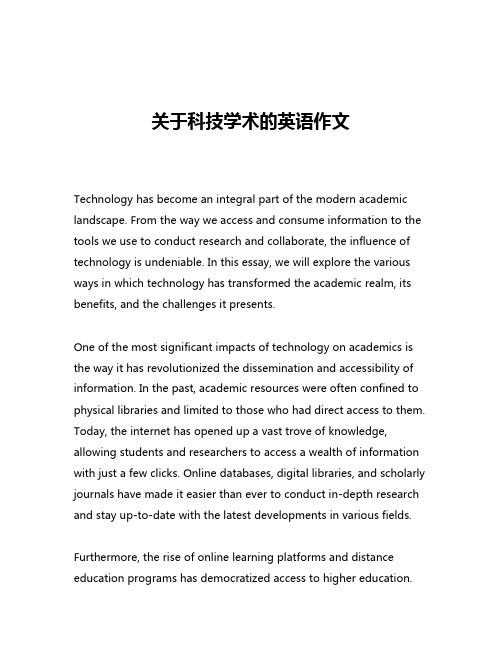
关于科技学术的英语作文Technology has become an integral part of the modern academic landscape. From the way we access and consume information to the tools we use to conduct research and collaborate, the influence of technology is undeniable. In this essay, we will explore the various ways in which technology has transformed the academic realm, its benefits, and the challenges it presents.One of the most significant impacts of technology on academics is the way it has revolutionized the dissemination and accessibility of information. In the past, academic resources were often confined to physical libraries and limited to those who had direct access to them. Today, the internet has opened up a vast trove of knowledge, allowing students and researchers to access a wealth of information with just a few clicks. Online databases, digital libraries, and scholarly journals have made it easier than ever to conduct in-depth research and stay up-to-date with the latest developments in various fields.Furthermore, the rise of online learning platforms and distance education programs has democratized access to higher education.Students who may have been geographically or financially constrained can now enroll in courses and programs offered by prestigious institutions around the world. This has not only expanded educational opportunities but has also fostered a more diverse and inclusive academic community.The integration of technology in the classroom has also revolutionized the learning experience. Interactive whiteboards, multimedia presentations, and virtual simulations have made learning more engaging and immersive. Students can now actively participate in the learning process, rather than passively absorbing information. This has led to increased retention, better understanding of complex topics, and the development of critical thinking and problem-solving skills.Moreover, technology has enabled new modes of collaboration and communication among academics. Platforms like video conferencing, online collaboration tools, and cloud-based storage have made it easier for researchers and scholars to work together, regardless of their physical location. This has facilitated the exchange of ideas, the sharing of resources, and the acceleration of knowledge production.However, the integration of technology in academics is not without its challenges. One of the primary concerns is the issue of digital equity and access. While technology has the potential todemocratize education, it also has the risk of exacerbating existing disparities. Students from low-income backgrounds or underserved communities may not have the same level of access to technology, resulting in a digital divide that can hinder their educational opportunities.Another challenge is the need for digital literacy and the development of critical digital skills. As technology becomes increasingly central to academic work, students and researchers must be equipped with the necessary skills to navigate the digital landscape effectively. This includes the ability to evaluate the reliability and credibility of online sources, to manage digital information, and to use technology-based tools and platforms responsibly and ethically.Furthermore, the rapid pace of technological change can also pose challenges for academics. Keeping up with the latest advancements, integrating new technologies into teaching and research, and adapting to changing digital environments can be a constant struggle. This requires ongoing professional development, training, and a willingness to embrace lifelong learning.Additionally, the integration of technology in academics has raised concerns about data privacy, security, and the ethical use of technology. Academics must navigate the complex landscape of datamanagement, ensuring the protection of sensitive information and the responsible use of technology-based tools and platforms.Despite these challenges, the benefits of technology in academics are undeniable. By embracing and effectively integrating technology, academic institutions can enhance the learning experience, foster collaborative research, and drive innovation in their respective fields. As we move forward, it is crucial that we address the challenges and work towards a future where technology is leveraged to its full potential in service of academic excellence and the advancement of knowledge.In conclusion, the impact of technology on academics is profound and multifaceted. From the democratization of information to the transformation of the learning experience, technology has reshaped the academic landscape. While there are challenges to be addressed, the opportunities presented by technology are immense. By navigating these changes with foresight, adaptability, and a commitment to digital equity and ethical practices, the academic community can harness the power of technology to drive progress, foster collaboration, and expand the boundaries of human knowledge.。
科技文献翻译
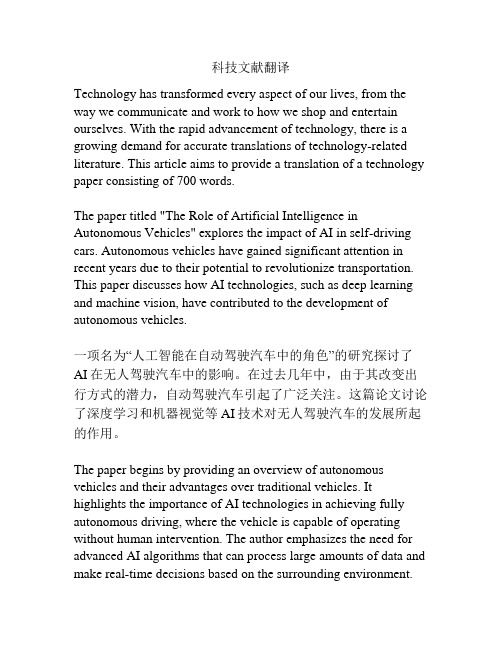
科技文献翻译Technology has transformed every aspect of our lives, from the way we communicate and work to how we shop and entertain ourselves. With the rapid advancement of technology, there is a growing demand for accurate translations of technology-related literature. This article aims to provide a translation of a technology paper consisting of 700 words.The paper titled "The Role of Artificial Intelligence in Autonomous Vehicles" explores the impact of AI in self-driving cars. Autonomous vehicles have gained significant attention in recent years due to their potential to revolutionize transportation. This paper discusses how AI technologies, such as deep learning and machine vision, have contributed to the development of autonomous vehicles.一项名为“人工智能在自动驾驶汽车中的角色”的研究探讨了AI在无人驾驶汽车中的影响。
在过去几年中,由于其改变出行方式的潜力,自动驾驶汽车引起了广泛关注。
科学技术议论文英语作文
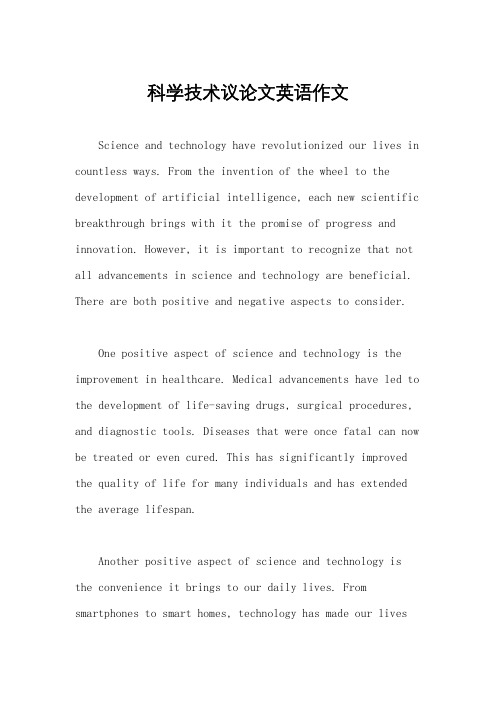
科学技术议论文英语作文Science and technology have revolutionized our lives in countless ways. From the invention of the wheel to the development of artificial intelligence, each new scientific breakthrough brings with it the promise of progress and innovation. However, it is important to recognize that not all advancements in science and technology are beneficial. There are both positive and negative aspects to consider.One positive aspect of science and technology is the improvement in healthcare. Medical advancements have led to the development of life-saving drugs, surgical procedures, and diagnostic tools. Diseases that were once fatal can now be treated or even cured. This has significantly improved the quality of life for many individuals and has extended the average lifespan.Another positive aspect of science and technology is the convenience it brings to our daily lives. From smartphones to smart homes, technology has made our liveseasier and more efficient. We can now communicate with people around the world in an instant, access information at our fingertips, and automate tasks that were once time-consuming. This has allowed us to be more productive and has opened up new opportunities in various fields.However, it is important to acknowledge the negative aspects of science and technology as well. One major concern is the impact on the environment. Industrialization and technological advancements have led to increased pollution, deforestation, and depletion of natural resources. This has resulted in climate change, loss of biodiversity, and other environmental problems. It is crucial for scientists and technologists to find sustainable solutions to minimize these negative effects.Another negative aspect of science and technology is the potential for misuse or abuse. Nuclear weapons, for example, have the power to cause mass destruction. Advances in genetic engineering raise ethical concerns about tampering with the natural order of life. It is important for society to have regulations and ethical guidelines inplace to ensure that science and technology are used for the benefit of humanity and not for harm.In conclusion, science and technology have brought about numerous positive changes in our lives, from advancements in healthcare to increased convenience. However, it is important to be mindful of the negative impacts, such as environmental degradation and thepotential for misuse. As we continue to make scientific and technological advancements, it is crucial to prioritize sustainability, ethics, and the well-being of both individuals and the planet.。
英文文献科技类原文及翻译

本科毕业设计(论文)外文翻译姓名: 王文超学号: 200715010220专业: 电气工程及其自动化班级: 电气071502指导教师: 智泽英职称:副教授日期: 2011年6月12日电子信息工程学院The basics of Computer Numerical ControlWhile the specific intention and application for CNC machines vary from machine type toanother, all forms of CNC have common benefits. Though the thrust of this presentation is to teach you CNC usage, it helps to understand why these sophisticated machines have become so popular. Here are but a few of the more important benefits offered by CNC equipment.The first benefit offered by all forms of CNC machine tools is improved automation. The operator intervention related to producing workpieces can be reduced or eliminated. Many CNC machines can run unattended during their entire machining cycle, freeing the operator to do other tasks. This gives the CNC user several side benefits including reduced operator fatigue, fewer mistakes caused by human error, and consistent and predictable machining time for each workpiece. Since the machine will be running under program control, the skill level required of the a CNC operator (related to basic machining practice) is also reduced as compared to a machinist producing workpieces with conventional machine tools.The second major benefit of CNC technology is consistent and accurate workpieces. Today’s CNC machines boast almost unbelievable accuracy and repeatability specifications. This means that once a program is verified, two, ten, or one thousand identical workpieces can be easily produced with precision and consistency.A third benefit offered by most forms of CNC machine tools is flexibility. Since these machines are run from programs, running a different workpiece is almost as easy as loading a different program. Once a program has been verified and executed for one production run, it can be easily recalled the next time the workpiece is to be run. This leads to yet another benefit, fast change-overs. Since these machines are very easy to setup and run, and since programs can be easily loaded, they allow very short setup time. This is imperative with today’s Just-In-Time product requirements.1. Motion control-the heart of CNCThe most basic function of any CNC machine is automatic, precise, and consistent motion. Rather than applying completely mechanicaldevices to cause motion as is required on most conventional machine tools, CNC machines allow motion control in a revolutionary manner. All forms of CNC equipment have two or more directions of motion, called axes. These axes can be precisely and automatically positioned alongtheir lengths of travel. The two most common axis types are linear (driven along a straight path) and rotary (driven along a circular path).Instead of causing motion by turning cranks and handwheels as is required on conventional machine tools, CNC machines allow motions to be commanded through programmed commands. Generally speaking, the motion type (rapid, linear, and circular), the axes to move, the amount of motion and the motion rate (feedrate) are programmable with almost all CNC machine tools.Accurate positioning is accomplished by the operator counting the number of revolutions made on the handwheel plus the graduations on the dial. The drive motor is rotated a corresponding amount, which in turn drives the ball screw, causing linear motion of the axis. A feedback device confirms that the proper amount of ball screw revolutions has occurred.A CNC command executed within the control (commonly through a program) tells the drive motor to rotate a precise number of times. The rotation of the drive motor in turn rotates the ball screw. And the ball screw causes drives the linear axis. A feedback device at the opposite end of the ball screw allows the control to confirm that the commanded number of rotations has taken place.Though a rather crude analogy, the same basic linear motion can be found on a common table vise. As you rotate the vise crank, you rotate a lead screw that, in turn, drives the movable jaw on the vise. By comparison, a linear axis on a CNC machine tool is extremely precise. The number of revolutions of the axis drive motor precisely controls the amount of linear motion along the axis.How axis motion is commanded-understanding coordinate systems. It would be infeasible for the CNC user to cause axis motion by trying to tell each axis drive motor how many times to rotate in order to command a given linear motion amount. (This would be like having to figure out how many turns of the handle on a table vise will cause the movable jaw to move exactly one inch!) Instead, all CNC controls allow axis motion to be commanded in a much simpler and more logical way by utilizing some form of coordinate system. The two most popular coordinate systems used with CNC machines are the rectangular coordinate system and the polar coordinate system. By far, the move popular of these two is the rectangular coordinate system, and we’ll use it for all discussions made during this presentation.。
学术论文翻译
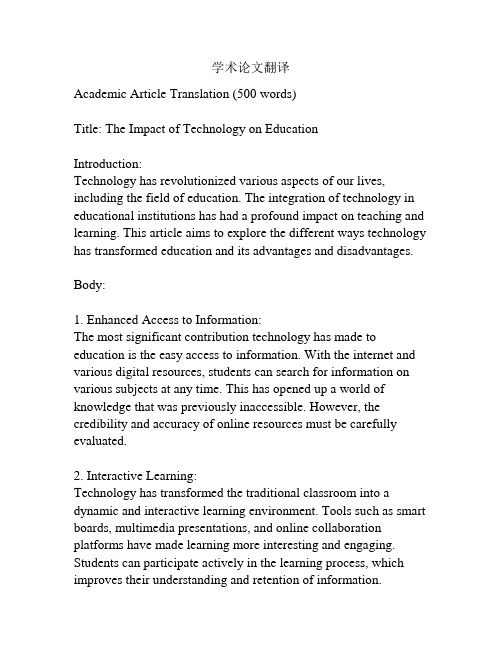
学术论文翻译Academic Article Translation (500 words)Title: The Impact of Technology on EducationIntroduction:Technology has revolutionized various aspects of our lives, including the field of education. The integration of technology in educational institutions has had a profound impact on teaching and learning. This article aims to explore the different ways technology has transformed education and its advantages and disadvantages.Body:1. Enhanced Access to Information:The most significant contribution technology has made to education is the easy access to information. With the internet and various digital resources, students can search for information on various subjects at any time. This has opened up a world of knowledge that was previously inaccessible. However, the credibility and accuracy of online resources must be carefully evaluated.2. Interactive Learning:Technology has transformed the traditional classroom into a dynamic and interactive learning environment. Tools such as smart boards, multimedia presentations, and online collaboration platforms have made learning more interesting and engaging. Students can participate actively in the learning process, which improves their understanding and retention of information.3. Personalized Learning:Technology allows for personalized learning experiences tailored to each student's needs and abilities. Adaptive learning software and online assessments can track individual progress and provide personalized recommendations and feedback. This individualized learning approach ensures that students can learn at their own pace and focus on areas they find challenging.4. Global Connectivity:Technology has connected students and educators from around the world. Through online platforms and video conferencing, students can collaborate with peers from different countries, exchange ideas, and broaden their cultural perspectives. This global connectivity fosters a sense of global citizenship and prepares students for a more interconnected world.5. Challenges and Concerns:Despite the numerous advantages, technology integration in education also poses challenges and concerns. One major concern is the digital divide, where students from economically disadvantaged backgrounds may not have equal access to technology and digital resources. This inequality can further widen the education gap.Another concern is the potential distraction caused by technology. Students may be tempted to engage in non-educational activities using devices, leading to a decrease in focus and productivity. It is essential for educators to find a balance between incorporating technology into the curriculum and minimizing distractions.Conclusion:Technology has undoubtedly transformed education, enhancing access to information, promoting interactive and personalized learning, and connecting students globally. However, it is crucial to address the challenges and concerns that come with the integration of technology. Education institutions should strive to bridge the digital divide and implement proper strategies to maximize the benefits of technology in education.。
经典翻译范文之科技篇中英文对照

中国热门科技词汇科学发展观concept of scientific development全民科学文化素质scientific and cultural qualities of the entire people发展科技scientific and technological advancement科教兴国revitalize China through science and education农业技术agricultural technology[扩展]白色农业white agriculture (microbiological agriculture and biological cell agriculture)超级杂交水稻super-hybrid rice技术下乡spreading the application of science and technology in rural areas节水农业water-saving agriculture立体农业3-D agriculture农产品加工及转化the processing and commercialization of agro-products农业科技agro-science农作物良种seeds of high-quality crop农作物新品种选育the selection and breeding of new crops生态农业environmental-friendly agriculture无土栽培soil -less cultivationBP机,传呼beeper, pager背投屏幕rear projection screen不明飞行物unidentified flying object (UFO)operating system 操作系统产品科技含量technological element of a product创新innovation电话会议teleconference电话留言机answering machine对讲机talkie and walkie多媒体multimedia二期the second phase防抱死系统ABS (anti-lock braking system)孵化器incubator高产优质high yield and high quality高技术产业化apply high technology to production高科技板块high-tech sector高科技园high-tech park个人数字助理PDA (personal digital assistant)工业园区industrial park国家质量技术监督局the State Bureau of Quality and Technical Supervision 国家重点实验室national key laboratories火炬计划Torch Program (a plan to develop new and high technology)计算机中央处理器central processing unit(CPU)技术产权technology property right技术交底confide a technological secret to someone.technology-intensive product 技术密集产品交叉学科interdisciplinary branch of science科技成果转化为生产力transfer of scientific and technological achievements into productive forces科技含量technology content科技基础设施science and technology infrastructure科技是第一生产力Science and technology constitute a primary productive force科技体制改革reform of the science and technology management system科技与经济脱节science and technology are out of line from the economy科教兴国rejuvenate the country through science and education可持续发展战略strategy of sustainable development纳米nanometer三峡水利枢纽工程the key water control project at the Three Gorges on the Yangtze River物种起源origin of species新兴学科new branch of science研究成果research results在孵企业incubated enterprises自动取款机automatic teller machine (ATM)自然科学与社会科学的交叉融合integration of natural and social sciencesIT 信息技术[扩展]信息港info port信息高地information highland信息高速公路information superhighway信息革命information revolution信息含量information content信息化informationization信息技术处理ITA - Information Technology Agreement信息检索information retri办公自动化OA (Office Automation)笔记本电脑laptop / notebook / portable computer电脑病毒computer virus电脑犯罪computer crime电子管理e-management电子货币e-currency电子商务e-business; e-commerce电子商务认证e-business certification电子邮件E-mail非对称数字用户环路ADSL (Asymmetrical Digital Subscriber Loop)高速宽带互联网high-speed broadband networks公告板BBS (bulletin board system)光盘杂志CD-ROM magazine广域网WAN (wide area net word)汉字处理软件Chinese character processing softwarehacker 黑客计算机2000年问题Y2K problem计算机辅助教育CAI -computer assisted instruction计算机辅助设计CAD-computer assisted design计算机合成制造CAM-computer assisted manufacturing计算机中央处理器CPU - central processing unit超文本传送协议hypertext transfer protocol (HTTP)界面interface金融电子化computerized financial services局域网LAN - local area network互联网服务提供商ISP (Internet Service Provider)全球移动通信系统(全球通)global system for mobile communications (GSM)刻录机CD burner宽带接入broadband access宽带网broadband networks内联网、局域网(计算机)Intranet垃圾邮件junk mail千年问题、千年虫millennium bug; Y2K bug人工智能AI - artificial intelligence人机交互human - computer interaction人机交互human-computer interaction虚拟人visual humanvirtual net 虚拟网虚拟网virtual net虚拟现实virtual reality虚拟银行virtual bank因特网服务提供商ISP- internet service provider万维网World Wide Web(WWW)应用软件internet applications域名domain在线on line掌上电脑palm computer政府上网工程Government Online Project只读存储器read-only-memory (ROM)智能感知技术perceptive technology智能终端intelligent terminal中文信息处理系统Chinese information processing system 数码科技digital technology高保真Hi-Fi (High Fidelity)高清晰度电视high definition TV (HDTV)光谷optical valley光通讯optical communication蓝光光盘Blue -ray Disc数码港cyber portdigital globe 数字地球数字蜂窝移动通信digital cellular mobile telecommunications三维电影three-dimensional movie三维动画three-dimensional animation[详析] “蓝光光盘”利用蓝色的激光束来刻录数据。
科技论文英译汉
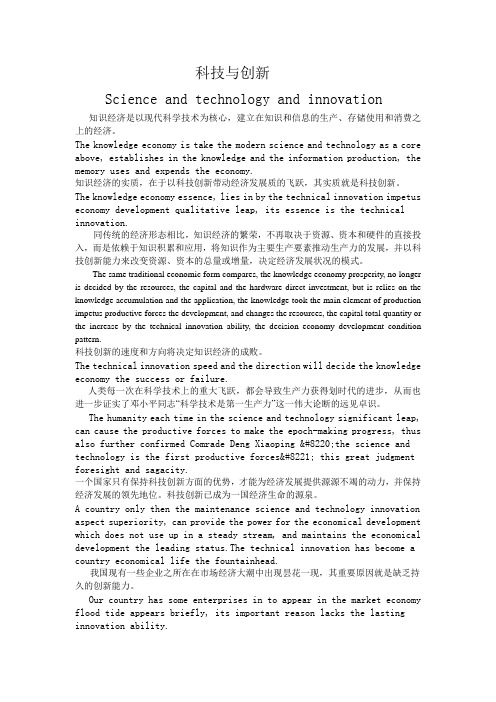
科技与创新Science and technology and innovation 知识经济是以现代科学技术为核心,建立在知识和信息的生产、存储使用和消费之上的经济。
The knowledge economy is take the modern science and technology as a core above, establishes in the knowledge and the information production, the memory uses and expends the economy.知识经济的实质,在于以科技创新带动经济发展质的飞跃,其实质就是科技创新。
The knowledge economy essence, lies in by the technical innovation impetus economy development qualitative leap, its essence is the technical innovation.同传统的经济形态相比,知识经济的繁荣,不再取决于资源、资本和硬件的直接投入,而是依赖于知识积累和应用,将知识作为主要生产要素推动生产力的发展,并以科技创新能力来改变资源、资本的总量或增量,决定经济发展状况的模式。
The same traditional economic form compares, the knowledge economy prosperity, no longer is decided by the resources, the capital and the hardware direct investment, but is relies on the knowledge accumulation and the application, the knowledge took the main element of production impetus productive forces the development, and changes the resources, the capital total quantity or the increase by the technical innovation ability, the decision economy development condition pattern.科技创新的速度和方向将决定知识经济的成败。
英文学术论文翻译中英文对照(三)
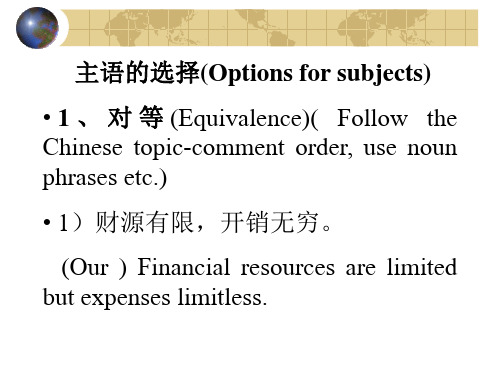
• 3)希望今后上海能够与更多 的外国城市结为友好城市。
It’s hoped that Shanghai will establish friendly relations with more foreign cities in the future.
One of the greatest challenges for an architect is a renovation of an operating hotel.
3. Supplement
• 1) 弄得不好,就会前功尽弃。
If things are not properly handled, our labor will be totally lost. • 2) 没有调查研究就没有发言权。
主语的选择(Options for subjects)
• 1 、 对 等 (Equivalence)( Follow the Chinese topic-comment order, use noun phrases etc.)
• 1)财源有限,开销无穷。
(Our ) Financial resources are limited but expenses limitless.
• 4、Use "it"
• 1)有朋自远方来,不亦乐乎。
Isn’t it a great pleasure to meet friends from afar? • 2)这个都市圈设想按五个层次展开。
It is conceived that the city areas will be built into five divisions.
He who makes no investigation and study has no right to speak.
什么是科技论文英文作文

什么是科技论文英文作文英文,A scientific paper is a written document that presents the results of a research study or experiment. Itis usually written by scientists or researchers in order to communicate their findings to other scientists, researchers, or the general public. Scientific papers are oftenpublished in academic journals or presented at scientific conferences.There are several different types of scientific papers, including research papers, review papers, and case studies. Research papers are the most common type, and theytypically include an introduction, a literature review, a methodology section, a results section, and a discussion section. Review papers, on the other hand, summarize and analyze existing research on a particular topic, while case studies describe a specific example or case in detail.One of the key features of a scientific paper is thatit is based on empirical evidence. This means that theresearch study or experiment was conducted in a systematic and objective manner, and the results are based on data that was collected and analyzed using rigorous methods. Scientific papers also typically include a detailed description of the methodology used, so that other scientists can replicate the study and verify the results.中文,科技论文是一种书面文件,它介绍了一项研究或实验的结果。
科技论文翻译
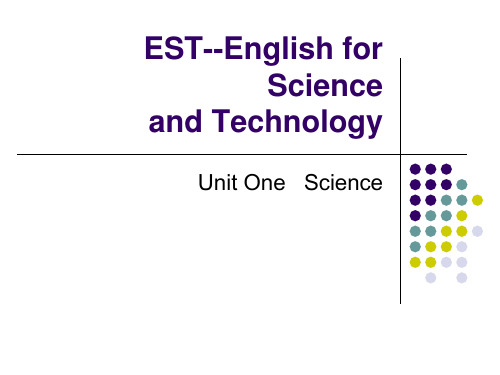
is obtained known as developed humid climate to satisfy the requirement attempts were made a method was discovered synthetic superior inferior to at present
Achieve Accuracy in EST
1. Using Specific Expressions
The reflected light was taken in by the transducer. The reflected light was absorbed by the transducer. (more specific)
Practice
Thus the study of radioactivity began as a piece of pure research, but its results are now applied in a great number of different ways--- in cancer treatment in medicine, the development of fertilizers in agriculture, the study of metalfatigue in engineering, in methods of estimating the ages of objects in anthropology and geology, etc. 所以, 放射性的研究, 是作为一项纯理论研究开始的, 但其 成果,现在却以各种不同的方式得到应用: 医学上用于治 疗癌症,农业上用于研制肥料,工程学上以研究金属疲劳, 人类学、地质学等方面,则把它应用在估算研究对象年 代的方法中。
英文学术论文翻译-中英文对照(三)
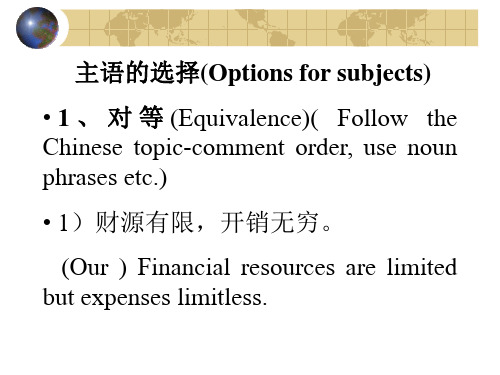
•These new measures will, we believe, increase the people’s purchasing power and lead to thriving financial and commercial conditions rather than make a mess of the country’s finances as some people argue.
一、主谓单句
汉语的主谓单句,从外形结构 上来看,跟英语的“主谓”结构是 相似的,但它的主语和谓语表达却 与英语有许多不同的地方。所以翻 译汉语主谓单句时,至少应注意几 个问题。
1、防止主语的机械对应。 中国近几年来发生了巨变。 ①There have been great changes in China these years. ②These years have seen (witnessed) great changes in China. ③Great changes have taken place in China these years. ④China crackles with the dynamics of changes these years.
汉语的基本句型及其翻译
汉语造句以名词为重心,以词组、散句和 分句为手段,善于按时间、逻辑顺序进行横 排式叙述,有时断句不严,外形松散。有人 称汉语是时间型的动态结构,主要体现于形 式自由,富于弹性。
英语则以“主—谓”主干结构为重心来统 领各种语言成分,句界分明,外形严密。 因此,汉语各种句型译成英语时,不仅在 逻辑关系上而且在外形上都应该体现出英语 句法结构的特点。
2-3 Reversing • 1)沿路都是小商店。 Small shops dot the way. • 2)他这样悍然行事使我们非常气恼。 Hot anger burned in our minds against him at his rashness.
科技英语写作(1)—What is a scientific paper

• Realize that your objective in research is to formulate and test hypotheses, to draw conclusions from these tests, and to teach these conclusions to others. Your objective is not to “collect data.” 要意识到研究的目的是为了形成并证 实假说,从一些测试中得出结论,并 把结论传授给别人。你的研究目的不 是简单的收集数据。
7
• How should you construct an outline? The classical approach is to start with a blank piece of paper, and write down, in any order, all important ideas that occur to you concerning the paper. Ask yourself the obvious questions:―Why did I do this work?‖ ―What does it mean?‖―What hypothesis did I mean to test?‖―What ones did I actually test?‖―What were the results?‖―Did the work yield a new method or compound? What?‖―What measurements did I make?‖―What compounds? How were they characterized?‖ Sketch possible equations, figures, and schemes. • 你应该如何起草你的提要?最经典的方法就是找一页空白 的纸,以任何顺序,写下与这篇文章有关的所有重要观点。 自问一些显而易见的问题:为什么我要做这项工作?它意 味着什么? 我要验证哪些假设? 我究竟验证了哪些假设? 结果如何? 这项工作产生了新方法或新物质吗?都是什么? 我都做了那些测试?什么化合物? 它们是如何表征的?展 示相关的方程,图表和示意图。
英文科技文献及翻译

外文翻译DC GENENRATORS1. INTRODUCTIONFor all practical purposes, the direct-current generator is only used for special applications and local dc power generation. This limitation is due to the commutator required to rectify the internal generated ac voltage, thereby making largescale dc power generators not feasible.Consequently, all electrical energy produced commercially is generated and distributed in the form of three-phase ac power. The use of solid state converters nowadays makes conversion to dc economical. However, the operating characteristics of dc generators are still important, because most concepts can be applied to all other machines.2. FIELD WINDING CONNECTIONSThe general arrangement of brushes and field winding for a four-pole machine is as shown in Fig.1. The four brushes ride on the commutator. The positive brusher are connected to terminal A1 while the negative brushes are connected to terminal A2 of the machine. As indicated in the sketch, the brushes are positioned approximately midway under the poles. They make contact with coils that have little or no EMF induced in them, since their sides are situated between poles.Figure 1 Sketch of four-pole dc matchineThe four excitation or field poles are usually joined in series and their ends brought out to terminals marked F1 and F2. They are connected such that they produce north and south poles alternately.The type of dc generator is characterized by the manner in which the fieldexcitation is provided. In general, the method employed to connect the field and armature windings falls into the following groups (see Fig.2):Figure2 Field connections for dc generators:(a)separately excited generator;(b)self-excited,shunt generator;(c)series generator;(d)compound generator;short-shunt connection;(e)compoundgenerator,long-shunt connection.The shunt field contains many turns of relatively fine wire and carries a comparatively small current, only a few percent of rated current. The series field winding, on the other hand, has few turns of heavy wire since it is in series with the armature and therefore carries the load current.Before discussing the dc generator terminal characteristics, let us examine the relationship between the generated voltage and excitation current of a generator on no load. The generated EMF is proportional to both the flux per pole and the speed at which the generator is driven, EG=kn. By holding the speed constant it can be shown the EG depends directly on the flux. To test this dependency on actual generators is not very practical, as it involves a magnetic flux measurement. The flux is produced by the ampere-turns of the field coils: in turn, the flux must depend on the amount of field current flowing since the number of turns on the field winding is constant. This relationship is not linear because of magnetic saturation after the field current reaches a certain value. The variation of EG versus the field current If may be shown by a curve known as the magnetization curve or open-circuit characteristic. For this a given generator is driven at a constant speed, is not delivering load current, and has its fieldwinding separately excited.The value of EG appearing at the machine terminals is measured as If is progressively increased from zero to a value well above rated voltage of that machine. The resulting curve is shown is Fig.3. When Ij=0, that is, with the field circuit open circuited, a small voltage Et is measured, due to residual magnetism. As the field current increases, the generated EMF increases linearly up to the knee of the magnetization curve. Beyond this point, increasing the field current still further causes saturation of the magnetic structure to set in.Figure 3 Magnetization curve or open-circuit characteristic of a separately excited dc machine The means that a larger increase in field current is required to produce a given increase in voltage.Since the generated voltage EG is also directly proportional to the speed, a magnetization curve can be drawn for any other speed once the curve is determined. This merely requires an adjustment of all points on the curve according ton n x E E G G ''where the quantities values at the various speeds.3. VOLTAGE REGULATIONLet us next consider adding a load on generator. The terminal voltage will then decrease (because the armature winding ha resistance) unless some provision is made to keep it constant. A curve that shows the value of terminal voltage for various load currents is called the load or characteristic of the generator.Figure 4 (a) directs current it to urge the generator load characteristics; (b) circuit diagramFig.4 shows the external characteristic of a separately excited generator. The decrease in the terminal voltage is due mainly to the armature circuit resistance RA. In general,A A G t R I E V -=where Vt is the terminal voltage and IA is the armature current (or load current IL) supplied by the generator to the load.Another factor that contributes to the decrease in terminal voltage is the decrease in flux due to armature reaction. The armature current established an MMF that distorts the main flux, resulting in a weakened flux, especially in noninterpole machines. This effect is called armature reaction. As Fig.4 shows, the terminal voltage versus load current curve does not drop off linearly since the iron behaves nonlinear. Because armature reaction depends on the armature current it gives the curve its drooping characteristic.4. SHUNT OR SELF-EXCIITED GENRATORSA shunt generator has its shunt field winding connected in parallel with the armature so that the machine provides its own excitation, as indicated in Fig.5. The question arises whether the machine will generate a voltage and what determines the voltage.For voltage to “build up ” as it is called, there must be some remanent magnetism in the field poles. Ordinarily, if the generator has been used previously, there will be some remanent magnetism. We have seen in Section 3 that if the field would be disconnected, there will be small voltage Ef generated due to this remanent magnetism, provided that the generator is driven at some speed. Connecting the field for self-excitation, this small voltage will be applied to the shunts field and drive a small current through the field circuit. If this resulting small current in the shunt field is of such a direction that it weakens the residual flux, the voltage remains near zeroand the terminal voltage does not build up. In this situation the weak main pole flux opposes the residual flux.Figure 5 Shunt generator:(a)circuit;(b)load characteristicIf the connection is such that the weak main pole flux aids the residual flux, the induced voltage increases rapidly to a large, constant value. The build-up process is readily seen to be cumulanve. That is, more voltage increases the field current, which in turn increases the voltage, and so on. The fact that this process terminates at a finite voltage is due to the nonlinear behavior of the magnctic circuit. In steady state the generated voltage is causes a field current to flow that is just sufficient to develop a flux required for the generated EMF that causes the field current to flow.The circuit carries only dc current, so that the field current depends only on the field circuit resistance, Rf. This may consist of the field circuit resistance Rf, the field current depends on the generated voltage in accordance with Ohm ’s law.It should be evident that on a new machine or one that has lost its residual flux because of a long idle period, some magnetism must be created. This is usually done by connecting the field winding only to a separate dc source for a few seconds. This procedure is generally known as flashing the field.Series GeneratorsAs mentioned previously, the field winding of a series generator is in series with the armature. Since it carries the load current the series field winding consists of only a few turns of thick wire. At no load, the generated voltage is small due to residual field flux only. When a load is added, the flux increases, and so does the generated voltage. Fig.7 shows the load characteristic of a series generator driven at a certain speed. The dashed line indicates the generated EMF of the same machine with the armature open-circuited and the field separately excited. The difference between the two curves is simply the IR drop in the series field and armature winding, such that)(S A A G t R R I E V +-=where RS is the series field winding resistance.Figure 7 Series generator: (a)circuit diagram;(b)load characteristicsCompound Generators The compound generator has both a shunt and a series field winding, the latter winding wound on top of the shunt winding. Fig.8 shows the circuit diagram. The two windings are usually connected such that their ampere-turns act in the same direction. As such the generator is said to be cumulatively compounded.The shunt connection illustrated in Fig.8 is called a long shunt connection. If the shunt field winding is directly connected across the armature terminals, the connection is referred to as a short shunt. In practice the connection used is of little consequence, since the shunt field winding carries a small current compared to the full-load current. Furthermore, the number of turns on the series field winding. This implies it has a low resistance value and the corresponding voltage drop across it at full load is minimal.Curves in Fig.9 represents the terminal characteristic of the shunt field winding alone. By the addition of a small series field winding the drop in terminal voltage with increased loading is reduced as indicated. Such a generator is said to be undercompounded. By increasing the number of series turns, the no-load and full-load terminal voltage can be made equal; the generator is then said to be flatcompounded. If the number of series turns is more than necessary to compensate for the voltage drop, the generator is overcome pounded. In that case the full-load voltage is higher than the no-load voltage.Figure 9 Terminal characteristics of compound generators compared with that of the shunt generatorThe overcompounded generator may be used in instances where the load is at some distance from the generator. The voltage drops in the feeder lines are the compensated for with increased loading. Reversing the polarity of the series field in relation to the shunt field, the fields will oppose each other more and more as the load current increase. Such a generator is said to be differentially compounded. It is used in applications where feeder lines could occur approaching those of a short circuit. An example would be where feeder lines could break and short circuit the generator. The short-circuit current, however, is then limited to a “safe”value. The terminal characteristic for this type of generator is also shown in Fig.9. Compound generators are used more extensively than the other types because they may be designed to have a wide varity of terminal characteristics.As illustrated, the full-load terminal voltage can be maintained at the no-load value by the proper degree of compounding. Other methods of voltage control are the use of rheostats, for instance, in the field circuit. However, with changing loads it requires a constant adjustment of the field rheostat to maintain the voltage. A more useful arrangement, which is now common practice, is to use an automatic voltage regulator with the generator. In essence, the voltage regulator is a feedback control system. The generator output voltage is sensed and compared to a fixed reference voltage deviation from the reference voltage gives an error signal that is fed to a power amplifier. The power amplifier supplies the field excitation current. If the error signal is positive, for example, the output voltage is larger than desired and the amplifier will reduce its current drive. In doing so the error signal will be reduced to zero.中文翻译直流发电机1.介绍对于所有实际目的来说,直流发电机仅用于特殊场合和地方性发电厂。
- 1、下载文档前请自行甄别文档内容的完整性,平台不提供额外的编辑、内容补充、找答案等附加服务。
- 2、"仅部分预览"的文档,不可在线预览部分如存在完整性等问题,可反馈申请退款(可完整预览的文档不适用该条件!)。
- 3、如文档侵犯您的权益,请联系客服反馈,我们会尽快为您处理(人工客服工作时间:9:00-18:30)。
列入表中
are listed in
is presented in
are summarized in
is shown in
As we know, the sample failure time of step-stress test in Table II has to be converted into the failure time at constant-stress.
The physical parameters of the flue gas are given in Table.
如图所示
The specific coupling relationship is illustrated in Fig. (示意图、流程图)
can be found from Fig.
as shown in
is plotted in Fig. 2,
Fig. 5a and b respectively show
Fig. 6 gives dynamic curves of
Fig. 7 displays the characteristic curves of the maximum amplitude of the plate versus the magnitude of the applied magnetic field with different impulse parameter time
The detailed iterative procedures are displayed in Fig.
Fig. 8 plots the characteristic curves of the critical value varying with the length–thickness ratio of the plate for different electric conductivity
10. the numerical results shown in Fig. 7 exhibit that
1 From Fig. 7, it will be found that
1 It can be found, from Fig. 5a, that
1 , shown in Fig. 5b,
1 It is found from Fig. 3 that
1 Similar to Fig. 7, Fig.9 also exhibits that
1 Fig. 8 exhibits that
1 The curves given in Figs. 8 and
1 Fig.5 compares present overall efficiency with the result got by Huang Z. et al. (2007). It is very clear that the calculated overall efficiency shows a very good agreement with the one
1 Comparing Fig. 6 (a) and (b),
20. As shown in Fig. 6 (b), (c) and (d),
2 Two effects of applied magnetic field on PM5 collection efficiency can be further identified in Fig. 10.
2 Fig. 6 depicts the vipation divergence curves of maximum displacement and
Mises stress under three conditions with UFSI considered, and it is clear that:
2 Fig. 6 depicts the vipation divergence curves of maximum displacement and
Mises stress under three conditions with UFSI considered, and it is not difficult to find that
2 the maximum Mises stress of the blade also increases with time and divergence
phenomenon becomes visible (see Fig. 6 (b), (d) and (f)).
从……看出
It can be seen that
It is very clear that the calculated overall efficiency shows a very
good agreement with the one
It can be seen in Fig. 9 that
Furthermore, it is identified that
Fig. 11 presents the PM5 overall efficiency under the same conditions as used in Fig. 10.
which is consistent with the second point drawn from Fig. 10.
Further, from top four curves in Fig. 12, it can be seen, at a given particle size that (see Figs. 10 and 11)
公式描述
combining (16) and Fig. 2, the following transition formula is obtained:
can be written as
can be rewritten as。
